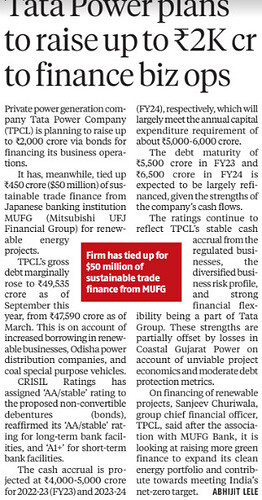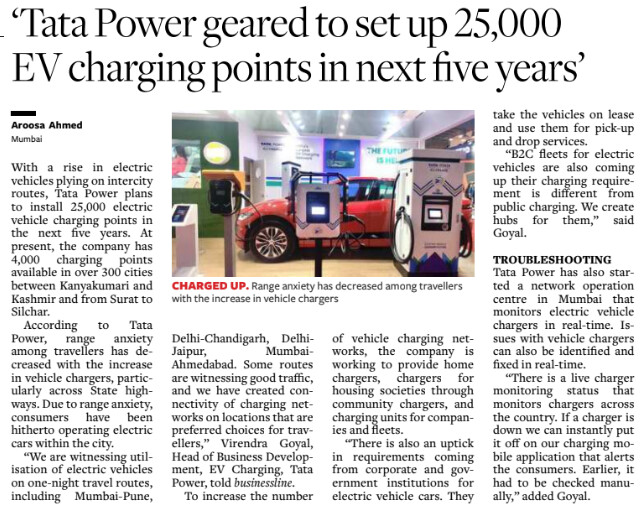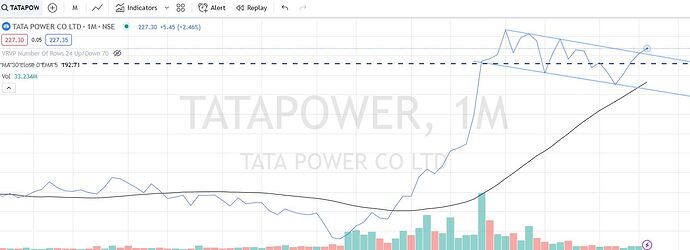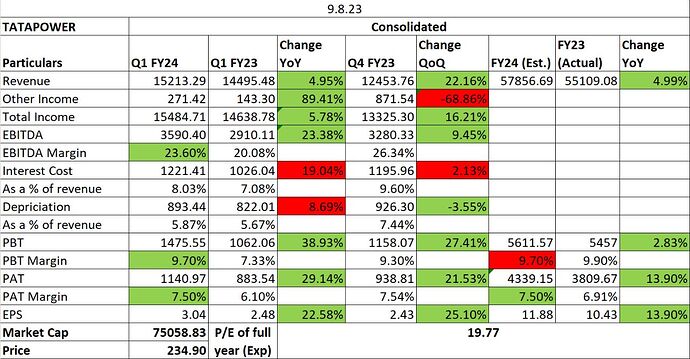latest update here is a superb thing for tata power as market was expecting 100% profit sharing with Govt for the mundra plant power generation. Tata power overhang is now out of the picture and infact tata power stands to benefit much more as they are allowed to sell to open market + they can pass through any incremental cost pressures in RM like coal prices. Awesome news i must say + it makes a fundamental bottom for the stock now.
Good set of numbers
I think it beat the street estimates on the net profit , revenue and margin front
Does anyone have the details about this green hydrogen pilot project?
Is it going to be setting up third party electrolyzers in tandem with a solar park, is it investing in their own electrolyzer technology stack, or something else entirely?
I would love to understand where Tata Power wants to participate in the green hydrogen value chain.
As of now media report on Tata power’s Green Hydrogen project is by bits and pieces…But if I gather them together, it appears they have definite plans.
A couple of weeks back, Tata projects (Tata Power has 48% stake in Tata projects) announced that they are entering in to EPC segments of Green hydrogen.
Thanks for providing that context.
The EPC model is a great way to enter the space. The setting up of multiple green H2 plants will help build Tata’s execution and commissioning capabilities.
However, I do hope that they try to backward integrate and get directly involved in the assembly and manufacturing of electrolyzers, hydrogen storage units, battery storage systems, etc., so as to be involved in a greater portion of the value chain.
The Business
Tata Power (TPR) is India’s Largest Integrated Power Company with a generation capacity of 12,808 MW reaching 12.1 million customers. It has been the No 1 Solar EPC player seven years in a row with more than 30% in clean energy.
Tata Power, formerly a part of the three entities jointly known as Tata Electric Companies, is a pioneer in technology adoption and is India’s largest integrated power company.
TPR has started focusing on new age businesses in addition to its regulated business of power generation, transmission & distribution. EV charging, Solar rooftops, Solar pumps, Solar modules and cells, micro grids, utility scale solar EPC, solar RO systems and home automation systems are its new ventures and will drive the business of the future.
They have started investing in intellectual property and has received 2 patents in FY21.
GLOBAL INDUSTRY DETAILS
- With an increasing number of nations responding to the challenge of climate change, the energy landscape is undergoing change, with greater focus being lent to cleaner sources of energy. More than 100 countries have pledged carbon neutrality by 2050 and many more such commitments are on the horizon.
- Renewable capacity addition has beaten all previous records, with more than 260 GW being added in 2020, exceeding 2019 growth by 50% as reported by IRENA (International Renewable Energy Agency)
- Share of renewables in new capacity additions rose considerably for the second year in a row, accounting for more than 80% of the capacity additions, with solar and wind accounting for 91% of the renewables.
- As per International Energy Agency (IEA) World Energy Outlook 2020, renewables are expected to overtake coal as the primary means of producing global electricity in 2025.
- As per a Hydrogen Council report, there are more than 200 large-scale projects for a combined $ 300 billion of proposed investment through 2030.
- The three Ds – Decentralisation, Decarbonisation and Digitalisation – are driving transformation of the energy sector, creating opportunities for new business models like Energy-asa-Service (EaaS), which is likely to further disrupt the utility sector.
INDIA INDUSTRY DETAILS
- Govt of India plans to raise renewable energy capacity from targeted level of 175 GW in 2022 to 450 GW by 2030.
- Another major focus area of the government has been increased participation of private players in the Transmission and Distribution (T&D) space, through the Tariff-based Competitive Bidding (TBCB) route in transmission and PPP (Public-Private Partnership) or franchisee models in the distribution segment in a bid to improve performance. Distribution continues to be
- The weakest link in the power value chain, which faces challenges of high Aggregate Technical & Commercial (AT&C) losses, insufficient tariff hikes resulting in a widening Average Cost of Supply (ACS)–Average Revenue Realised (ARR) gap, accumulation of regulatory assets and cross-subsidisation.
Transformation plans for the future:
- New business: From a commodity player to a service provider for the end consumer.
- Customer growth in focus: From a ~ 3 million customer base in FY’ 20 to 20 million customer base in FY’25.
- Portfolio transformation: From a 30% clean portfolio to over 60 % Renewables portfolio in FY’25.
- Growth scale-up: From 12.8 GW to 25 GW capacity in FY’25.
Rooftop solar
- Market to grow from 6.6MW to 30MW by FY25
- Target of 5000 cr of revenues from solar roof tops by FY25
Residential and Industrial rooftop solar:
- 30,000+ total & 15,000+ residential customers.
- 500+ MW installed, ~40% CAGR (FY18-21)
- Ranked No 1 Solar EPC Player for 7 years in a row
- Pan India network of 250+ Channel Partners
Solar-powered water pumps:
- Over 35,000 Pumps across India
- Market Leader in Solar Pumps.
- Govt is encouraging the use of solar pumps for irrigation purposes under the KUSUM scheme with a 60% subsidy. The aim is to reach 3.5 mn farmers. Tata Power has 30K+ and is expecting to reach 1L+ by FY26.
Future Plans
- TPR has decided not to invest any further capital into coal based generation. TPR will phase out coal-based generation completely as their respective power purchase agreements (PPAs) expire, e.g. Maithon FY35, Mundra FY37, Trombay extended by five years to FY24 and Jojobera FY31/32.
- TPR has planned to move to 60% clean energy by FY25, 80% by FY30 and 100% by FY50.
- TPR expects commissioning of 900MW of its Renewable Energy projects over the next 6-9 months. It has doubled its solar PV manufacturing capacity to 1,100 MW of cell and modules under Tata Power Solar Systems Limited.
- The management expects to incur a capex of Rs.7000-8000 cr in FY22. Around 50% of this would be for its Renewables portfolio, while another Rs.1000 cr is related to Odisha DISCOMs.
- The company has prepaid 1,500 crs of 11.4% perpetual debt. The net debt slightly increased to 38,898 crs. The prepayment of high-cost debt has helped reduce the interest cost from 7.99% last year to 6.95% this year. The net debt to equity stood at 1.7-1.57 compared to 1.81 last year. Net debt to underlying EBITDA has also come down to a healthy 4.1x.
- Company expects Solar EPC to boost up its earnings for the next two years. The large-scale utility EPC order book continues to grow, with orders worth 743 crs won in Q1FY22, taking the total order book as on 30 June at 7,257 crs.
The future focus is on renewables
- Renewable energy unit IPO: Company is planning to raise just over Rs. 3,500cr by listing its renewables business.
- The company has a roadmap to be one of the major players in India in EV charging. It has tied up with OEM partners to provide home charging facilities to EV car buyers.
- It has set up close to 500 public charging points in nearly 100 cities and plans to expand to over 3,000 charging points in the next one year. It has also collaborated with fleet owners which serves as an assured revenue model. TPR plans to extend their charging points to 1 lakh by FY25.
- They have collaborated with Central Railway to launch EV charging points at Mumbai’s railway stations.
Electricity Amendment Bill 2021
De-license power distribution
- Allowing private sector players to enter the sector and compete with state-owned power discoms
- Giving consumers a choice to choose a distribution company in their area
- Universal service obligation to ensure companies do not cherry pick customers
Mandatory Renewable Purchase Obligation (RPO)
- Penal provision for missing purchase obligation
Experience from Orissa to manage urban, rural and semi-rural to be very helpful
- Tata Power has taken over the entire state’s power distribution
- Orissa distribution to be profitable by FY22
Tata Sons is backing the changes
- Tata Sons has reposed faith in the company and has bought into 2,600 cr of equity share capital on preferential basis. This has resulted in Tata Sons’ shareholding going from 35.27% in FY20 to 45.21% in FY21.
- Dr. Praveer Sinha is the CEO & Managing Director of the company and is a PhD. from IIT, Delhi with over 36 years of industry experience. He is also the Co-Chairman of the CII National Committee on Power as also on various Industry bodies. He is one of the most well-respected people in the industry.
- TPR tops the CRISIL ESG score for power companies in India.
Risks and Challenges
- Distribution continues to be the weakest link in the power value chain, which faces challenges of high Aggregate Technical & Commercial (AT&C) losses, insufficient tariff hikes resulting in a widening Average Cost of Supply (ACS)–Average Revenue Realised (ARR) gap, accumulation of regulatory assets and cross-subsidisation.
- COVID-19 induced challenges led to further deterioration in the financial position of Discoms as the deferment of bill payments by consumers reduced collections, thereby putting pressure on their revenues and limiting their ability to pay the Generating Companies.
- Receivables have increased from 4500 cr as of Mar-20 to Rs5600 cr as of Mar-21, however, they have remained stable at 55 days of sales in FY21.
- Fluctuation in coal prices and / or USD-INR currency can create challenges for the Mundra UMPP as it is dependent on imported coal
Tata Power
Coal: The management highlighted that Tata Power saw strong contribution from its coal companies owing to elevated coal prices, with Q3FY23 revenue, Ebitda and PAT of Rs 5200 crore (up 45 per cent YoY), Rs 1,100 crore (down 25 per cent YoY) and Rs 950 crore (up 59 per cent YoY), respectively. Consequently, the share of profit from associates increased to Rs 1,000 crore in Q3FY23 from Rs 660 crore in Q3FY22, but lower than Rs 1,200 crore in Q2FY23. However, prices of imported coal have dropped to $232 per tonne in Q3FY23 from $320 per tonne in Q2FY23.
Maithon: The management highlighted that Maithon reported revenues of Rs8.1 bn in 3QFY23. It stated that the increase of 21 per cent YoY was primarily due to the +16 per cent YoY rise in unit sales during the quarter, with 4 per cent growth in realizations. Margins improved to 25.5 per cent.
Tata Power Solar: Tata Power Solar’s revenues rose 26 per cent YoY to Rs 1,430 crore, but declined 8 per cent QoQ, with the Ebitda margin declining to 7 per cent (versus 10 per cent in 3QFY22 and 11 per cent in 2QFY23). Tata Power’s solar rooftop revenues were robust at Rs 530 crore (up 41 per cent YoY, down 7 per cent QoQ). It currently has a capacity of 1 GW (~4.5 GW total market size). Management stated that the company currently has an order book of Rs14 bn, and plans to increase revenues from its solar rooftop segment to Rs 10,000 crore (from the Rs 2500 crore annual run-rate now) by FY2027, as it reaches a capacity of 2.5-3.0 GW.
Renewables: Tata Power highlighted that PLFs for its solar plants were stable at 23 per cent, whereas PLFs for wind plants weakened. Management stated that the installed capacity increased marginally to 2.85 GW in Q3FY23, with solar capacity standing at 2.07 GW and wind capacity at 0.78 GW.
Mundra: The company stated that it is yet to reach any agreement with the states on the Mundra power plant, which is currently operating at very low capacity (10-15 per cent PLF, as of January 2023). However, it believes that the Section 11 order (from last year) could be implemented again, as the power demand increases in the summer season.
Long-term guidance: The management expects renewables, thermal power and T&D to contribute 50 per cent, 15 per cent and 35 per cent of profits over the next 4-5 years (versus FY2022 contribution of 22 per cent, 50 per cent and 28 per cent, respectively). Accordingly, 80 per cent of its ongoing capex is toward renewable power generation. Tata Power’s AT&C losses have declined to ~26 per cent levels from ~45 per cent earlier, better than its own expectations and largely in line with the government’s target. It has reduced its net debt-to-Ebitda level to 3 times from 6 times over the last few years, and would target to keep it below 3.5 times going forward.
Tata is a major player in the power generation and transmission business in India, generating a large amount of electricity in the past year. They have also invested heavily in developing infrastructure for electric vehicle charging stations, both at homes and public locations, and have plans to increase their customer base significantly in the coming years.
Tata has set ambitious goals to shift their energy generation mix from 66% coal and 34% renewable sources to 80% renewable and 20% coal by 2030, and ultimately to 100% renewable by 2040. This aligns with global efforts to reduce carbon emissions and move towards a sustainable energy future.
The company has a diverse portfolio of renewable energy sources, including thermal, hydro, wind, and solar, with an installed capacity in the thousands of megawatts. They have also made significant investments in the development of solar panels.
Tata’s vision of building an ecosystem for electric vehicles includes utilizing its power generation and transmission expertise to create a network of charging stations powered by renewable energy, including solar panels developed by the company. This strategy positions Tata to be a major player in the emerging electric vehicle market in India and contributes to the global effort to transition to a more sustainable energy future.
Tata Power Q1 FY24 Results Update:
- Become carbon net zero before 2045.
- Become water neutral before 2030.
- Zero waste to landfill before 2030.
- Solar Rooftop, Pump Business Orders: Order Book (Incl. Group Captive) at Q1 FY24 end stands at ₹ 2,500+ crore. Strong traction seen in Group Captive with orders of 415 MW won in Q1 FY24. Installed 112 MW in Q1 FY24. Channel network crosses 480+ across 275+ districts.
- Solar cell and module manufacturing project remains on track: First module production expected by end of Sep-23 and first cell production by Q4FY24. The management emphasized towards improving the margins in solar rooftop and pump business. The prices of solar cells & modules and wafers reduced significantly, in Q1 FY24. The management expects with more capacity additions taking place in China and Southeast Asian countries, there would be an oversupply of cells & modules which would result in further reduction in prices, going forward.
- Tata Power maintained its FY24 capex guidance of Rs. 12,000 crore and aim to be below net debt/EBITDA of 3.5x.
- The company plans to add 2 GW to 2.5 GW of renewable capacity every year, with a focus on utility scale and group captive projects.
- Tata Power is also investing in pumped hydro projects, aiming to support 6 GW to 7 GW of renewable capacity for round-the-clock power.





